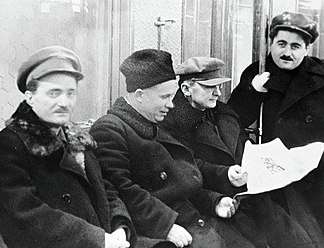Aghasi Khanjian
Aghasi Ghevondi Khanjyan (Armenian: Աղասի Ղևոնդի Խանջյան; Russian: Агаси Гевондович Ханджян, Agasi Gevondovich Khandzhyan) (January 30, 1901 – July 6, 1936) was First Secretary of the Communist Party of Armenia from May 1930 to July 1936.[1]
Aghasi Khanjyan | |
|---|---|
 Khanjyan in 1934 | |
| First Secretary of the Communist Party of Armenia | |
| In office May 1930 – July 1936 | |
| Preceded by | Haykaz Kostanyan |
| Succeeded by | Amatuni Vartapetyan |
| Personal details | |
| Born | January 30, 1901 Van, Ottoman Empire |
| Died | July 6, 1936 (aged 35) Tiflis, Georgian SSR, Soviet Union |

Biography
Khanjyan was born in the city of Van, Ottoman Empire (today eastern Turkey).[2] With the onslaught of the Armenian Genocide, his family emigrated from the city in 1915 and settled in Russian Armenia.[1][3] In 1917-19, he was one of the organizers of Spartak, the Marxist students' union of Armenia. He later served as the secretary of the Armenian Bolshevik underground committee.[3]
In 1920, Khanjyan became First Secretary of the Yerevan City Committee of the Communist Party of Armenia and in 1930, the first secretary of the Armenian Communist Party.[3] He proved to be a charismatic Soviet politician and was very popular among the Armenian populace.[1] He was a friend and supporter of many Armenian intellectuals, including Yeghishe Charents (who dedicated a poem to him), Axel Bakunts and Gurgen Mahari.[3] Khanjyan also tried unsuccessfully to have Moscow annex Nagorno-Karabakh to Armenia.[4] He was arrested in 1936 and died while being interrogated.[5] Ronald Grigor Suny describes the circumstances of his death as follows:
But by the mid-1930s Khanjyan had come into conflict with the most powerful party leader in Transcaucasia, Lavrenti Beria, a Georgian close to Stalin. Early in July 1936 Khanjyan was called to Tiflis. Suddenly and unexpectedly it was announced that the Armenian party chief had committed suicide.[2] Though the circumstances of his death are murky, it is believed that Beria had ordered Khanjyan's death to remove a threat to his own monopoly of power.[6]
According to Robert Conquest, Khanjyan was shot by Beria when he visited the latter's office.[7]
Along with an entire generation of intellectual Armenian communist leaders (such as Vagarshak Ter-Vaganyan), Khanjyan was denounced as an enemy of the people during the Great Purge.[1]
Khanjyan was officially rehabilitated after the death of Joseph Stalin.
See also
- Armenian SSR
- Vagarshak Arutyunovich Ter-Vaganyan
References
- Zev Katz, Rosemarie Rogers, Frederic Harned. Handbook of Major Soviet Nationalities. New York: Free Press, 1975, pp. 146-47.
- Suny 1993, p. 156.
- (in Russian) Great Soviet Encyclopedia. Aghasi Khanjian
- Armenian History: History of Artsakh, Part 2, Yuri Babayan
- Khronos biography.
- Ronald Grigor Suny, "Soviet Armenia," The Armenian People From Ancient to Modern Times, Volume II: Foreign Dominion to Statehood: The Fifteenth Century to the Twentieth Century, ed. Richard G. Hovannisian. New York: St Martin's Press, 1997, p. 362.
- Robert Conquest, The Great Terror: A Reassessment. Oxford: Oxford University Press, 2008, p. 225.
Sources
- Suny, Ronald Grigor (1993). Looking Toward Ararat: Armenia in Modern History. Indiana University Press. ISBN 978-0253207739.
Aghasi Khanjyan born in van.
CS1 maint: ref=harv (link)